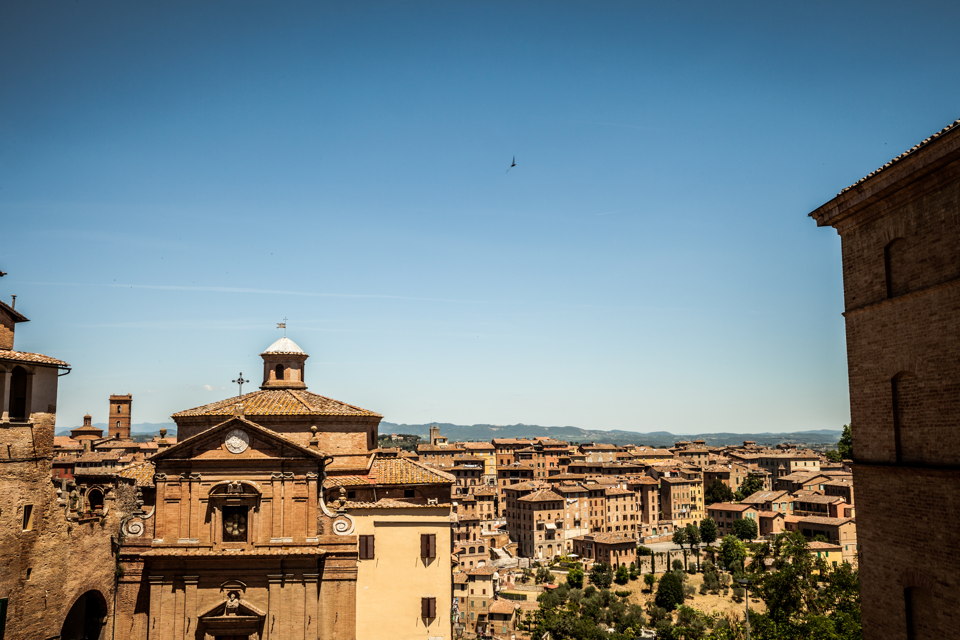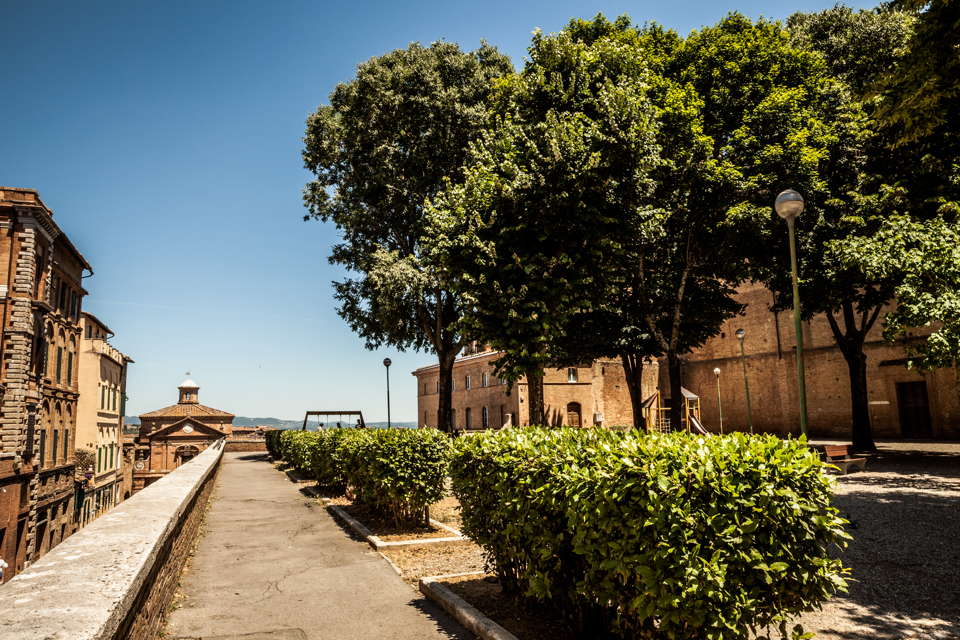





La chiesa di Sant’Agostino, con annesso convento, fu edificata a partire dalla metà del Duecento per ospitare i frati eremitani. La sua costruzione durò a lungo e ancora all’inizio del Trecento fervevano i lavori. Nella seconda metà del Quattrocento fu oggetto di ristrutturazione e di un ulteriore ampliamento. La chiesa, che con la sua mole domina il giardino antistante, denominato Prato di Sant'Agostino, fu però devastata nel 1747 da un furioso incendio e così otto anni dopo venne completamente rinnovata in veste neoclassica su disegno di Luigi Vanvitelli. Risale invece al 1819 la costruzione del portico esterno, recentemente restaurato, progettato da Agostino Fantastici. L'interno dell'edificio presenta una serie di altari in marmi policromi eretti tra il XVI e il XVII secolo, corredati da pale dipinte. Tra i numerosi capolavori ancora conservati, particolarmente degni di nota sono la Crocifissione di Pietro Perugino e le tele con il Battesimo di Costantino, il Sant'Antonio tentato e L'Adorazione dei Magi, rispettivamente riferibili a Francesco Vanni, Rutilio Manetti e al Sodoma. Risalenti all'assetto dell'edificio antecedente all'incendio sono invece gli affreschi spettanti a Francesco di Giorgio Martini e Luca Signorelli, recentemente riscoperti all'interno della Cappella Bichi, e quello di Ambrogio Lorenzetti nella Cappella Piccolomini, raffigurante la Madonna in trono con il Bambino e i Santi.
The church of Sant'Agostino, with an adjoining convent, was built starting from the middle of the thirteenth century to house the eremitani friars. Its construction lasted a long time and at the beginning of the XIV century the works were still underway. In the second half of the fifteenth century it was the subject of restructuring and further extension. The church, which with its towering size dominates the garden in front of it, called Prato di Sant'Agostino - was completely renovated following the design of Luigi Vanvitelli, after a disastrous fire that had devastated it in 1747. The construction of the external Portico instead dates back to 1819, recently restored, designed by Agostino Fantastici. The interior of the building presents a series of polychrome marble altars erected between the sixteenth and seventeenth century accompanied by painted altarpieces. Among the many masterpieces still preserved here, particularly noteworthy are the Crocifissione by Pietro Perugino and the paintings with the Battesimo di Costantino, the Sant'Antonio tentato and L'Adorazione dei Magi, respectively by Francesco Vanni, Rutilio Manetti and Sodoma. The frescoes by Francesco di Giorgio and Luca Signorelli instead date back to the set-up of the building before the fire, recently rediscovered inside the Bichi Chapels, and the one by Ambrogio Lorenzetti depicting the Madonna in trono con il Bambino e i Santi in the Piccolomini Chapel.
Die Kirche Sant'Agostino, mit angeschlossenem Kloster, wurde in der Mitte des dreizehnten Jahrhunderts gebaut, um den Eremiter Brüdern ein Zuhause zu geben. Der Bau dauerte lange und zu Beginn des XIV. Jahrhunderts waren die Arbeiten noch nicht abgeschlossen. In der zweiten Hälfte des 15. Jahrhunderts wurde die Kirche umgebaut und erweitert. Die imposante Kirche dominiert den Vorgarten, der Prato di Sant'Agostino genannt wird, der aber im Jahr 1747 von einem grossen Brand völlig zerstört wurde, und daher acht Jahre später im neo-klassizistischen Stil von Luigi Vanvitelli komplett renoviert wurde. Der Bau der kürzlich restaurierten Veranda, von Agostino Fantastici, stammt aus dem Jahr 1819. Im Inneren des Gebäudes gibt es eine Reihe von Altären aus polychromem Marmor, die zwischen dem 16. und 17. Jahrhundert mit Altaraufsätzen ausgemalt wurden. Unter den vielen noch erhaltenen Meisterwerken, sind besonders erwähnenswert, die Kreuzigung von Pietro Perugino, und die Gemälde mit der Taufe des Konstantin, “Sant'Antonio tentato” und “l'Adorazione dei Magi”, jeweils Francesco Vanni, Rutilio Manetti und Sodoma zuzuschreiben. Die Kirche enthält auch noch Original-Fresken von Francesco di Giorgio und Luca Signorelli, die vor dem Brand realisiert wurden, und die man vor kurzem in der Bichi Kapelle wiedergefunden hat, sowie ein Fresko von Ambrogio Lorenzetti in der Piccolomini Kapelle, das die “Madonna in trono con il Bambino e i Santi,” darstellt.
L’église de Sant’Agostino, avec son couvent adjacent, fut édifiée à partir de la moitié du XIIIe siècle afin d’accueillir les frères ermites. Sa construction dura longtemps et au début du XIVe siècle les travaux perdurèrent. Dans la seconde moitié du XVe siècle elle fut restaurée et agrandie. Puis en 1747 l’église et son jardin nommé “Prato di Sant'Agostino”, furent détruits par un grand incendie et l’église fut rénovée en style néoclassique sur dessin de Luigi Vanvitelli. Le portique externe remonte à 1819 et a été récemment restauré sur un projet d’Agostino Fantastici. L'intérieur de l'édifice présente une série d’autels en marbres polychromes construits entre le XVIe et le XVIIe siècle, et sont ornés de tableaux. Parmi les nombreuses œuvres encore conservées on peut noter la Crucifixion de Pietro Perugino et les toiles avec le “Battesimo di Costantino”, “Sant'Antonio tentato” et “ L'Adorazione dei Magi”, réalisées respectivement par Francesco Vanni, Rutilio Manetti et Sodoma. Les fresques de Francesco di Giorgio Martini et Luca Signorelli qui appartiennent à la période antécédente à l’incendie ont été récemment découvertes à l’intérieur de la chapelle Bichi, ainsi que celles d’Ambrogio Lorenzetti dans la Chapelle Piccolomini, représentant la Vierge à l’enfant sur le trône et Saints.
La iglesia de Sant’Agostino, con el convento anexo, fue construida a mediados del siglo XIII para albergar a los frailes ermitaños. Su construcción duró mucho tiempo y todavía a principios del siglo XIV seguían los trabajos. En la segunda mitad del siglo XV fue restructurada y se realizó una ampliación. La iglesia, que con su volumen domina el jardín delantero, llamado Prato de Sant’Agostino, sin embargo fue devastada en el 1747 por un gran incendio y ocho años más tarde fue completamente renovada con un estilo neoclásico bajo diseño de Luigi Vanvitelli. Del 1819, en cambio, es la construcción del pórtico externo, restaurado recientemente, fue proyectado por Agostino Fantastici. La parte interior del edificio presenta una serie de altares en mármol policromados construidos entre el siglo XVI y XVII, acompañados por retablos pintados. Entre las varias obras de arte todavía conservadas, destacan la Crucifixión de Pietro Perugino y las pinturas con el Bautismo de Costantino, el Sant’Antonio tentado y la Adoración de los reyes Magos, respectivamente atribuibles a Francesco Vanni, Rutilio Manetti y el Sodoma. Hay frescos antecedentes al incendio que pertenecen a Francesco di Guirgio Martini y Luca Signorelli, descubiertos recientemente en el interior de la Capilla Bichi, y el de Ambrogio Lorenzetti en la Capilla Piccolomini, que representa la Virgen en trono con el niño y los Santos.

Luoghi
A few hours or even just one day is definitely not enough to discover Siena and experience it in all its aspects.
Thanks to a priceless historical and artistic heritage and to a rich net of commercial activities, Siena offers many cultural, entertainment and travel opportunities. Breathtaking views and hidden corners, confirmations and surprises await you behind every alley and in every square with unusual perspectives to be discovered also through the itineraries that we show you in this page.
The routes that vary according to the number of days, to your passions, to the season and to the will to either walk or rather relax in the city's green spaces. Many different ways to achieve a single objective: making your travel experience in our city unforgettable.
So, enjoy Siena! And thank you for spending your free time in our city.
We’ll always remain here, waiting for your next visit.



